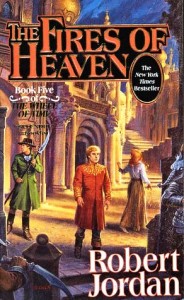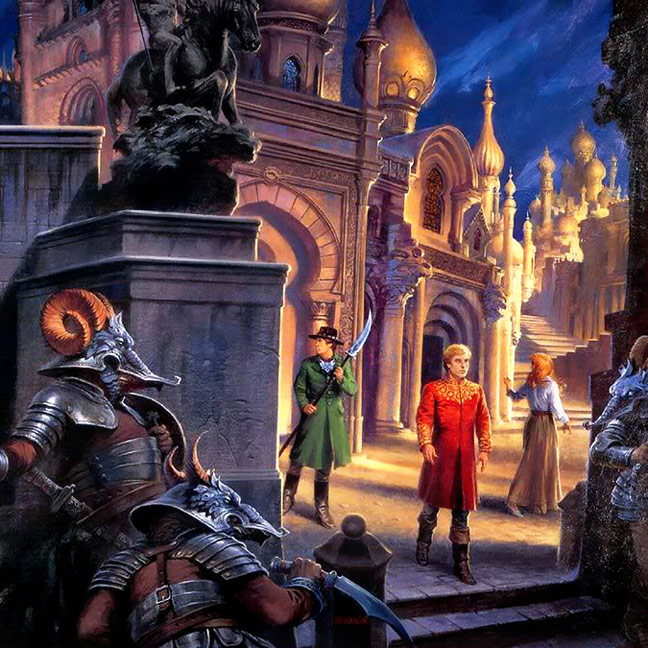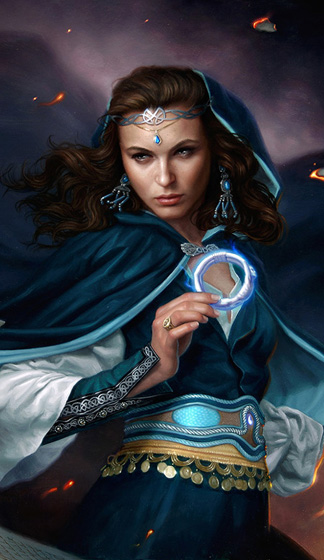
Five volumes into the Wheel of Time series, I find myself struggling more and more to pay close attention to all the details. The earlier novels were easier in that the number of subplots were very few and generally no more than a few chapters separated any bunching of each subplot. The narrative was relatively straight-forward and although the prose never was anything to write home about, enough interest was generated in the characters to make the first few novels at least bearable to read and on quite a few occasions, enjoyable.
However, by the fourth volume, The Shadow Rising, my interest began to waver. I noted in my previous commentary that I believed Jordan tried to cover too much, to explain more than what was vitally essential to the main plot of the series, that of the Dragon Reborn being readied for the upcoming Last Battle. Here in The Fires of Heaven, my complaints about the previous volume probably can be multiplied by at least a factor of ten. Although I recall enjoying this volume almost the same as the previous one when I first read it in 1997, a decade away from reading it has reminded me that time might have the ability to remove bad memories and to enhance the few positive ones that remained. The Fires of Heaven was at times a terrible mess of a novel to wade through.
[A] lamentable tendency to repeat the same line of approach over and over again becomes rather tiresome.
After opening with a lengthy prologue (if memory serves, each volume from here on out, the prologues end up being close in length to several short novels that were popular before the 1980s) and covering the aftermath of the Aes Sedai split (a subplot that I mentioned before perhaps could have best been combined into one shot in this volume), the scene shifts east to Rand and his motley Aiel crew lounging about in the now-open ancient city of Rhuidean. Lots and lots of scene setting going on here. Some developments between Rand and the spear maidens protecting him. Some more between Rand and the now-revealed third of his prophesied three honies, Aviendha. Lots and lots of sniffing about what men don’t understand about women, carried out in much the same way as had been the case before in the previous four volumes. Ad nauseam levels of it. Enough to make me wonder if the author had decided trying to discuss gender differences and ways of viewing the world was much more important than forwarding the overall plot of the novel. This is not to say that occasional examples of this, presented in various angles and guises, could not work. Rather, Jordan’s lamentable tendency to repeat the same line of approach over and over again becomes rather tiresome.

And yet the scenes surrounding Rand and those with him at the start of the novel are actually the high points of this novel. There is a rival, the Shaido Couladin, who serves to drive this subplot forward as he invades the Westlands ahead of Rand. Lots of slaughter, sometimes shown in detail. The fog of war is shown to good effect here, but there were times that even with the use of Mat as “the man on the streets” things felt a bit more distant than I think Jordan intended. But this is nitpicking, as outside the repetitive gender clashes, Rand’s (and for the most part, Mat’s) scenes were the best developed and had a better ratio of plot tension, character development, and some sense of resolution to a few of the obstacles that each had been facing recently.
The scenes with the female characters, however, were mostly a horror to read. Regardless of locale or imagined culture/society, it seems every female group in this novel has to resort to demeaning physical punishment in order to teach discipline. From swatting with nettles to having a slut’s hair shorn to copious scenes of female nudity for no other purpose than for there to be some sort of female bonding, these scenes felt more like slightly watered-down versions of things that might have appeared in a Gor novel than anything approaching a realistic portrayal of how a female-led hierarchical society might be like. Although after a while I was able to ignore it, things really weren’t all that thrilling to read, nor did I feel that much in the way of meaningful character development was occurring, unless teaching a young woman how to endure physical pain as a way of toughening her up is a great way to develop character.
 This book also features the infamous circus scenes, where I believe hundreds of pages are spent following Elayne and Nynaeve as they join a menagerie to escape from one of the female Forsaken baddies. The bickering, which had been acted out in books 2-4, pretty much repeats itself in form and pattern throughout here. It read as little more than a plot contrivance in order to make sure that the two trainees can have a place to stay until all the rebel Aes Sedai can meet in an abandoned village called Salidar.
This book also features the infamous circus scenes, where I believe hundreds of pages are spent following Elayne and Nynaeve as they join a menagerie to escape from one of the female Forsaken baddies. The bickering, which had been acted out in books 2-4, pretty much repeats itself in form and pattern throughout here. It read as little more than a plot contrivance in order to make sure that the two trainees can have a place to stay until all the rebel Aes Sedai can meet in an abandoned village called Salidar.
Not that too much was really developed once they reached there. A major structural problem that occurs when so much time is developed to expanding a half-dozen or so subplots is that either some are left out altogether in order to speed up their timelines (Perrin’s absence being a sign of this) or others (like the Tower split) have to have their arcs divided in a haphazard fashion across several novels, often with little real advancement or perceived narrative tension. This does not make for an exciting read for those readers who can easily keep track of all of this, but would rather that less attention be spent on repeating the same damn truisms and more time devoted to keeping a strong focus on the advancing scenes and plots to where they will (eventually) flow into the overarching plot. It is precisely in this novel (and to a lesser extent, the previous one) where I believe Jordan made some horrible plot decisions that weakened the flow of this series to the point where the next few volumes have very little plot advancement outside of an odd scene here and there in those books (and one where not even that occurs).
After a while, all sense of a coherent rhythm to the scenes vanishes, leaving just odd enjoyable scenes here and there, as islands surrounded by an ocean of tepid plot and character development.
While I can understand where some of the fans are going to enjoy the first major battle scenes of the series or how others might enjoy the comedy of manners moments that take place among some of the characters, the novel felt more like a Frankenstein’s monster in how ill-integrated these disparate narrative elements were intertwined. Although some might be pardoned for thinking otherwise, I highly doubt that the WoT series’ main focus is on a few somewhat amusing scenes. Nor do I think the political machinations, handled with about as much adroitness as a staggering drunk can dance the tango, are what this series purportedly is about. Sure, there are a few more plot prophecies thrown about to give some grist to the speculative mills of those readers who are more interested in playing “guess what plot development will occur next” than they are in how well structured and written these novels are. After a while, all sense of a coherent rhythm to the scenes vanishes, leaving just odd enjoyable scenes here and there, as islands surrounded by an ocean of tepid plot and character development. I read on, but the enjoyment is fading fast.


Wonderful review, Larry. I think your assessment of Jordan’s meandering plot from Book 4 forward is entirely fair. It’s at this point in the story where I also felt it took a big leap to the other side of relevant for an agonizing percentage of the book (s).
Like you, I recall being captivated while reading the Fires of Heaven when it first came out. Also like you, I struggled to read the series a second time so many years later. You mentioned the possibility of the mind’s willingness to forget the pain as a possible reason for this. I wonder if it isn’t that we’ve grown as readers – if indeed, the fantasy genre overall hasn’t evolved so dramatically from those 1990’s novels that reading some of those earlier series now (or at least Jordan’s work) isn’t a bit like returning to the Pulp era of SF. Jordan’s work doesn’t captivate in 2012 the way it did in 1997, pre-Facebook, YouTube and all the other distractions/stimulations of our plugged-in world consciousness.
Just wait till Crossroads of Twilight lol. I loved the series and had been waiting years for that volume but I couldn’t believe how slow it was…
Things definitely started going downhill from here. I had to stop halfway thru book ten and read the chapter summaries it was the worst waste of time ever. About to start 11 now